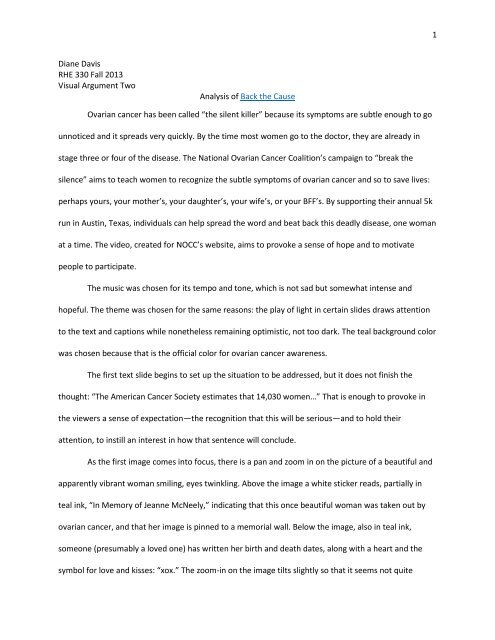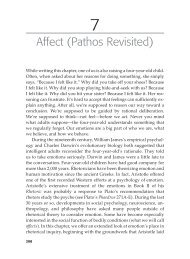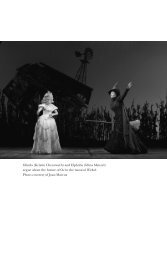example of a self-analysis - DWRL Instructor Web Pages
example of a self-analysis - DWRL Instructor Web Pages
example of a self-analysis - DWRL Instructor Web Pages
- No tags were found...
You also want an ePaper? Increase the reach of your titles
YUMPU automatically turns print PDFs into web optimized ePapers that Google loves.
1<br />
Diane Davis<br />
RHE 330 Fall 2013<br />
Visual Argument Two<br />
Analysis <strong>of</strong> Back the Cause<br />
Ovarian cancer has been called “the silent killer” because its symptoms are subtle enough to go<br />
unnoticed and it spreads very quickly. By the time most women go to the doctor, they are already in<br />
stage three or four <strong>of</strong> the disease. The National Ovarian Cancer Coalition’s campaign to “break the<br />
silence” aims to teach women to recognize the subtle symptoms <strong>of</strong> ovarian cancer and so to save lives:<br />
perhaps yours, your mother’s, your daughter’s, your wife’s, or your BFF’s. By supporting their annual 5k<br />
run in Austin, Texas, individuals can help spread the word and beat back this deadly disease, one woman<br />
at a time. The video, created for NOCC’s website, aims to provoke a sense <strong>of</strong> hope and to motivate<br />
people to participate.<br />
The music was chosen for its tempo and tone, which is not sad but somewhat intense and<br />
hopeful. The theme was chosen for the same reasons: the play <strong>of</strong> light in certain slides draws attention<br />
to the text and captions while nonetheless remaining optimistic, not too dark. The teal background color<br />
was chosen because that is the <strong>of</strong>ficial color for ovarian cancer awareness.<br />
The first text slide begins to set up the situation to be addressed, but it does not finish the<br />
thought: “The American Cancer Society estimates that 14,030 women…” That is enough to provoke in<br />
the viewers a sense <strong>of</strong> expectation—the recognition that this will be serious—and to hold their<br />
attention, to instill an interest in how that sentence will conclude.<br />
As the first image comes into focus, there is a pan and zoom in on the picture <strong>of</strong> a beautiful and<br />
apparently vibrant woman smiling, eyes twinkling. Above the image a white sticker reads, partially in<br />
teal ink, “In Memory <strong>of</strong> Jeanne McNeely,” indicating that this once beautiful woman was taken out by<br />
ovarian cancer, and that her image is pinned to a memorial wall. Below the image, also in teal ink,<br />
someone (presumably a loved one) has written her birth and death dates, along with a heart and the<br />
symbol for love and kisses: “xox.” The zoom-in on the image tilts slightly so that it seems not quite
2<br />
graspable as the caption comes into focus: “will die <strong>of</strong> ovarian cancer in 2013.” The woman is an<br />
<strong>example</strong>, then: she is one <strong>of</strong> the 14,030 women whose life has been taken this year by ovarian cancer.<br />
This image aims to provoke a sense <strong>of</strong> sadness because this woman, once so happy and healthy, is now<br />
gone, and <strong>of</strong> sympathy for those who loved and lost her and who are, clearly, still grieving for her.<br />
The image transitions to another text slide that opens with a flash <strong>of</strong> bright light (hope) before<br />
the text twists into view. The text, which has no punctuation, reads: “The National Ovarian Cancer<br />
Coalition / 5k to Break the Silence / Austin, TX / August 25, 2013 / Be there” The slide assures the viewer<br />
that there is something s/he can do to help “break the silence” and so prevent this disease from taking<br />
the lives <strong>of</strong> more women. The text is designed to provoke hope by articulating a task to be<br />
accomplished. To the question “can anything be done to prevent this?” or “what can I do to help?” the<br />
text slide responds: “yes” and “participate to spread the word.”<br />
The final image zooms and tilts in exactly the same way the first image did, tying the two images<br />
together in style and structure, but this time we are zooming in on a young woman dressed in running<br />
shorts, running shoes, and a t-shirt, walking away from the camera, presumably at the end <strong>of</strong> the abovementioned<br />
5k. As the image comes into focus, it becomes clear that on the back <strong>of</strong> this woman’s t-shirt<br />
is the same photo we saw pinned to the memorial wall in the first image. Above the photo on the t-shirt<br />
are the words: “I’ll remember.” So here, presumably, we are seeing the loved one (daughter?) who<br />
pinned the first woman’s photo to the memorial wall and drew the heart and the “xox” at the bottom <strong>of</strong><br />
it. She has taken the challenge to participate in the campaign to “break the silence,” which suggests to<br />
the viewer: so can you. The caption twists in, again with a beam <strong>of</strong> light, enjoining the viewer to “Back<br />
the cause.” The pun on the word “back” aims to give the reader a sense <strong>of</strong> “getting it” and so <strong>of</strong> being an<br />
intended addressee. The understanding that this woman is walking in memory <strong>of</strong> the other woman,<br />
perhaps her mother, provokes a sense <strong>of</strong> sympathy or compassion for her—for her loss and her grief—
3<br />
but also <strong>of</strong> hope more broadly because she is doing something with that grief, she is supporting a cause<br />
devoted to fighting the disease that took someone she loved (her mother?) from her.<br />
The presentation as a whole evokes the emotions <strong>of</strong> sadness or sorrow, <strong>of</strong> compassion, and<br />
then finally <strong>of</strong> hope: there may indeed be a way to fight this disease, and I might be able to help. The<br />
behavior the emotions are designed to prompt is active participation in the “break the silence”<br />
campaign. The video aims to get the viewer involved in the cause. The interpretation necessary to link<br />
the emotions to the desired behavior is a belief that spreading the word could actually make a<br />
difference, and that my participation could help to spread the word.<br />
Photo Credits:<br />
Image one: Memorial wall. Taken by Paul Mowery. Private collection.<br />
Image two: Woman walking. Taken by Paul Mowery. Private collection.










